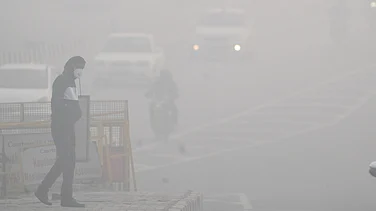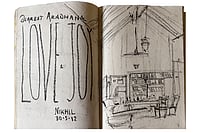Let me cry out in that void, say it as I can. I write on that void:
Kashmir, Kaschmir, Cashmere, Qashmir, Cashmir, Cashmire,
Kashmere, Cachemire, Cushmeer, Cachmiere, Cašmir. Or Cauchemar
in a sea of stories? Or: Kacmir, Kaschemir, Kasmere, Kachmire,
Kasmir. Kerseymere?
The Blesséd Word: A Prologue
by Agha Shahid Ali
Humne toh kabhi kholi hi nahi
Masood Hussain about the wishlist he had tied at the shrines in Kashmir
We tie the threads. We know the lies. It is about the wasteland that elsewhere they call paradise. There is no dateline to sadness here. That tree that they call the weeping willow has branches swooping down like an old woman’s eyelashes that have witnessed the disappearances and the deaths and have borne the weight of tears for years. This is why women wail at the shrines here. And this is why they tie the wish knots. That’s that doomed kind of hope. This is a country of barbed wire and wish knots, of guns and lotuses. The painter had said he had never been able to untie the wish knots. Many winters have passed. They say you untie the knots once your wish has been granted. Here, threads age like men and women. Peace never came to the Valley.
In 2016, I had met Masood Hussain at his house in Kashmir and he had laid out seven canvases that had been inspired by couplets the late poet Agha Shahid Ali had given to him in 2000. He said he managed to save those during the deluge that year, when the Jhelum had breached its walls and come to the city and bodies of cows floated on the flooded streets. Someone had said the tears of the people had made the Jhelum swell.
“We are sad people,” a man had once told me in Kashmir. I remember a quote from French director and photographer Agnes Varda. “If we opened up people, we’d find landscapes,” she said. In Kashmir, the landscape is then of flaming red trees and pristine snow and all of this beauty contained within concertina wires.
ALSO READ: Routes Of Grief: Two Translations
In Kashmir, they say the Chinar trees are their witness. They have been around for centuries. That autumn in 2016, a 60-foot Chinar tree had fallen on the campus of Kashmir University. Khytul Abyad, then a 23-year-old fine arts student, was there. That’s where we met. She said it was the only fallen tree among 600-odd Chinars. She called that an “unusual place”. The same year, a building there had caught fire. Inside the gutted building, reels of tapes were scattered like cobwebs and wrapped around the beams. What songs did these tapes have in those days? Saqib Bhat was born in 1993. “We share our birth with the conflict,” he told me then.
ALSO READ: Kashmir: Of ‘Stories’ And Friends
I had been looking for an artist who painted on electric bulbs. He painted Khomeini and he painted Amitabh Bachchan. He also painted barbed wire, and checkpoints. They said he migrated to Dubai to earn money. He was a labourer. I am not a spokesperson or archivist or a memorialist here. I am simply a reporter whose notebooks have these names and their stories, their quotes, the atmospherics, the underlined words. On one page, I had underlined “fallen tree”. On another, the word “letterpress”. Masood once had a letterpress printing agency. He named it Focus. This is when Kashmir wasn’t ravaged by insurgency. In the late 1980s, when it first began, Masood was printing logos and halafnamas for militants who would send for him.
There were new liberation parties and those messages needed to be related. He finally shut down the agency, and started painting. That was his way of documenting everything. By building an archive of memory. As an artist, he couldn’t get canvas. “I started painting on boards,” he had said. He told me the story of Mugli, a woman who was waiting for her son. They found her dead staring at the door. That’s death—hopeful, incomplete. He had slashed his painting of a white dove and three generations of women in Kashmir that he made in 2011. “We are trying to find someone who would heal our wounds...With the hope that somebody will come and stitch this painting for me,” he had said. At the back of the canvas, he had written “This is the paradise lost.” The letter ‘r’ was in red.
ALSO READ: The ‘Homeland’ Dream Of Kashmiri Pandits
This Wednesday, when I called Masood, he said the painting is still lying in his studio. Slashed, he said. “Nobody came to stitch it,” he said. I remember the seven canvases. A red shawl painted on one, golden Chinar leaves on another, a lone shikara on another. Heaven is an imposition of the gaze of the other, Masood had said. I was collecting memory postcards of what they had seen. Testimonies, drawings, photos.
There’s a fiery red Chinar that I had photographed once at night in 2016. My photographer friend said he wanted to plant a Chinar tree in Nagaland. And he hoped it would grow so he could get married under its fiery red leaves. He carried a sapling. He said they had red soil back home. Many years later, I asked him if Chinar trees grew in Nagaland. He said it didn’t. Conflict wasn’t enough common denominator for the tree to have grown in a place that too has AFSPA.
ALSO READ: Kashmir Files: Memories Of Another Day
Autumn isn’t the same everywhere. They say the Chinar trees give shade to the graveyards. All graves are stories and all stories have a context, a site and a landscape. The red colour, a Kashmiri had told me, gives the leaves its colour. We had been outside a cafe when he pointed out an old house. It used to belong to a Kashmiri Pandit family. The Muslims have taken care of it all this while, hoping they’d return. There is a film that is being talked about a lot. It’s called The Kashmir Files. In a place where cinema halls shut down when militancy began, people haven’t seen it. When I asked a poet to write about his life as a Kashmiri Muslim and his inheritance of loss, he asked who was willing to listen to him if he would say he suffered, too.
In one of the canvases titled Autumn Refrain in Kashmir, Agha Shahid had written “crimsoned spillage” and wrote about the colours of fire clinging to the Chinars. Masood remembered how in the streets a worker stood in front of the shop during a curfew. A stray bullet hit him. The painter was watching from the window. The worker shouted for help. A little boy came by pushing an empty cart and helped the Bihari migrant labourer onto the cart and took him to the hospital. A pool of blood was left behind. The couplet reminded him of the blood.
Perhaps that’s why Chinars grow here and become so red, he said. I never brought back a sapling. Not even a leaf. Only a picture of the flaming red tree because Kashmir and its stories are not a postcard series. There’s a lot of memories here. We dedicate this issue to the ones who left and the ones who stayed behind and to the fallen Chinar tree that became a canvas on which artists drew and wrote their stories. And the Chinar trees that stand still.
(This appeared in the print edition as "This Isn’t a Postcard Series")
ALSO READ


























